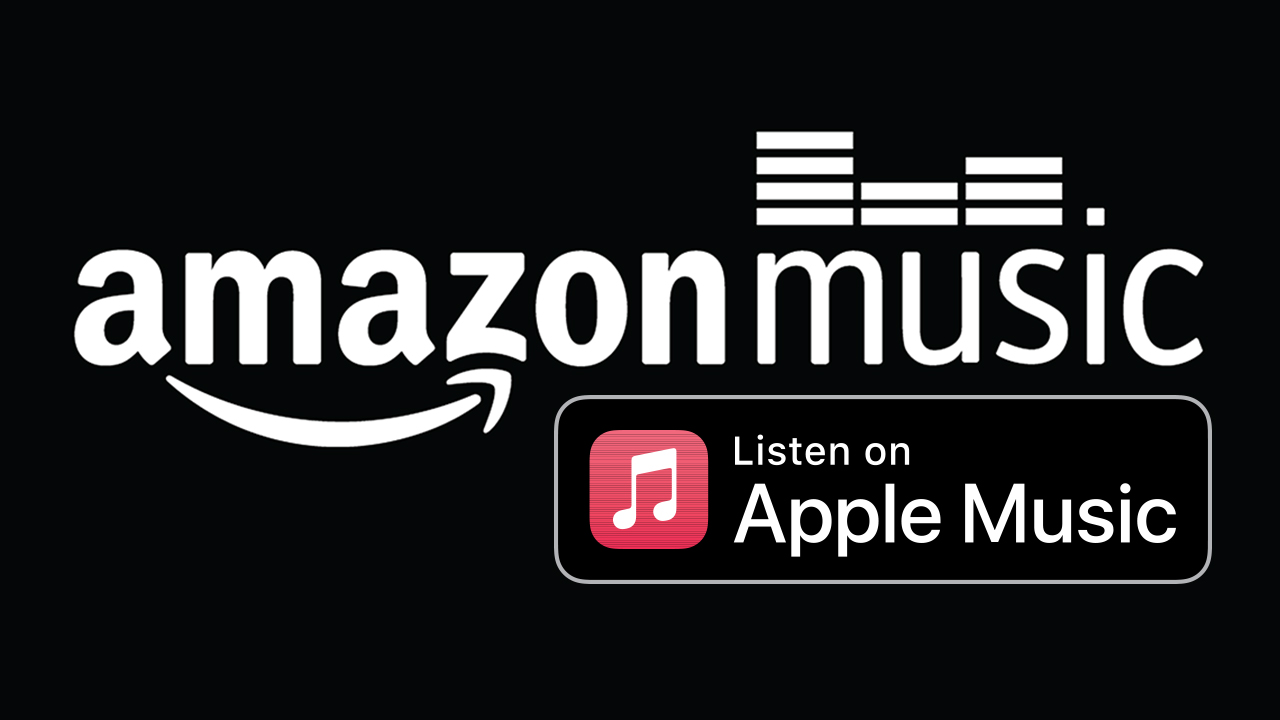Apple Music vs Amazon Music Unlimited: which streaming service rocks hardest?
Apple Music and Amazon Music Unlimited are both quality music streaming services, so I've put them side by side to see how they compare

1. At a glance
2. Content & quality
3. Price plans
4. Usability
5. Audio quality
6. Verdict
Music streaming services are part of the furniture now. A huge majority of us are reliant on services like Spotify, Apple Music and Amazon Music Unlimited not only for instantly accessing favoured riffs of old, but also for discovering new favourites – and all with hitherto unimaginable convenience.
There are a few markers that make an excellent streaming service, from library size to streaming quality to the accuracy of discovery algorithms and beyond. These markers make both Apple Music and Amazon Music Unlimited contenders for best-in-class when it comes to streaming the heavy stuff, but which one should you plump for?
If you're looking for a new music streaming service but remain on the fence between these two, I've put both through their paces to give you all the information you need before laying down your cash.
At a glance
Apple Music
- Price: $10.99/£10.99 monthly; $16.99/£16.99 Family Plan monthly;
Student plan $5.99/£5.99 monthly - Sound Quality: CD quality 16-bit/44.1kHz, Apple Music Lossless
24-bit/48kHz, Hi-Res Lossless
24-bit/192kHz - Spatial audio: Yes
- Sign up at Apple Music
- Apple Music review
Amazon Music Unlimited
- Price: $9.99/£9.99 monthly (Prime users), $10.99/£10.99 monthly (non-Prime users; $16.99/£17.99 Family Plan monthly; Single device: $5.99/£5.99/m
- Sound Quality: HD quality 16-bit/44.1kHz, UHD quality up to 24-bit/192kHz
- Spatial Audio: Yes
- Sign up at Amazon Music Unlimited
- Amazon Music Unlimited review
Overview
Apple Music was arguably the first in line to compete against disruptive streaming giant Spotify back in the earliest days of music streaming subscriptions, building off the back of its iTunes infrastructure to offer a comparable library with a familiar listening experience. Today, it’s a behemoth, with a comprehensive catalogue of more than 100 million songs, excellent genre reach and plenty of high-quality streaming options to boot.
Tracks labelled Hi-Res Lossless and Apple Digital Master are about as good as it gets when it comes to streaming quality and cranking Metallica's 72 Seasons is a case in point, but Apple reserves its best listening trick, Dynamic Head Tracking, exclusively for iPhone users. The same goes for its AI integration capabilities, as you can reach your music by talking (or indeed typing) to Apple devices’ virtual assistant Siri.
In all, Apple Music is an excellent choice if you’re an Apple devotee or a music fan who would like to dive into their ever-growing range of albums in Spatial Audio.
Amazon Music Unlimited, meanwhile, builds off the megalithic might of its parent company’s logistics absolutism – and, being slightly younger than Apple Music in its standalone streaming-service form, is counterintuitively a bit of an underdog. Indeed, it reflects this stature through offering a comparable library at a slightly more competitive subscription price – albeit a price only accessible if you already subscribe to Amazon Prime.
Amazon Music Unlimited is a little less impressive on the discovery and music curation front, but somewhat makes up for this with its broad selection of CD and Hi-Res quality tracks - labelled as HD and UHD. There’s also a comprehensive range of spatial audio tracks for you to discover.
Content & quality

There’s very little difference between the catalogue offerings of Amazon Music Unlimited and Apple Music. Both claim to have more than 100 million tracks, and there’s comprehensive representation from the classic rock, metal, prog, punk and alternative archives. You may stumble across a few discrepancies if you look really hard, but even when I got eclectic, both services rose to the challenge.
Both music streaming services also have a comparable number of high-fidelity encodes, with substantial 16-bit and 24-bit quality libraries. Apple Music presents its entire library in Lossless, and a good portion of its catalogue can also be heard as Hi-Res Lossless – meaning sample rates above 48kHz.
Amazon Music Unlimited, similarly, presents almost its entire library in HD, aka 16-bit, 44.1kHz-plus, CD-quality files; millions of tracks are also Ultra HD, meaning 24-bit and up to 192kHz. They’re pretty well-matched in this regard.
Price plans
Apple Music
Apple’s Individual Price plan costs $10.99/£10.99 a month, and there’s a $16.99/£16.99 Family Plan. There’s also a University Student plan, which costs $5.99/£5.99 per month.
Amazon Music Unlimited
Amazon Prime subscribers can subscribe to Amazon Music Unlimited for a discounted monthly fee of $9.99/£9.99, which makes the service cheaper than Apple music for Prime-sters; if you’re not on the Prime wagon, the price is the same as Apple’s at $10.99/£10.99 a month.
There’s also a $16.99/£17.99 family tier, and a single device plan (designed for use with Fire sticks or Amazon’s Echo devices) which costs $5.99/£5.99 monthly – though the latter plan doesn’t entitle you to anything higher than standard-quality streaming.
Usability
When it comes to general usability, Apple Music starts to show its class. As part of the setup process, the Apple Music app invites you to favour musical genres and artists. This really helps with music curation and recommendations. If you tell it you like Powerwolf, it’ll quickly get the message and point you to the likes of Sabaton and Hammerfall. Your ears are in good hands no matter what your music preferences.
It’s also easy to add artists, albums and tracks to your personal library, while playlists are easy to store and create. Apple also give you the opportunity to customise your playlist cover icon with a picture from your phone or use one of their pre-designed icons.
Amazon, however, takes a little longer to get to know your tastes. The ‘My Soundtrack’ station home page default is populated with artists and bands from your playback history, plus seemingly random additions (I play The Darkness so I get The Killers?). There’s also a ‘You Might Like’ rail which suggests I should listen to Sub.Vision as I like Ghost’s Impera. Amazon’s AI is clearly working hard here as it reasons, "If you like Tobias Forge here’s some more Tobias Forge."
Both Apple Music and Amazon Music Unlimited will please audiophiles with their clear labelling of Hi-Res and Dolby Atmos - which brings us neatly to audio quality.
Audio quality

Apple Music and Amazon Music Unlimited are both great choices if you want your playlists to sound crystal clear. What’s more, both services also offer Spatial Audio in the form of Dolby Atmos and 360 Reality Audio mixes on an increasing number of releases. For example, Machinery Of Torment by Skullflower from the Metal Lords soundtrack is a must-listen in fully immersive Dolby Atmos.
So nothing separates either service, you might think? Well, Apple has one spatial-audio trick that Amazon can’t match: Dynamic Head Tracking. Dynamic Head Tracking simulates the physical position of speakers around your head, and enables you to truly immerse yourself in the three-dimensionality of Dolby Atmos mixes. The catch, though, is that only iPhone users can use it. Further, you'll need Apple AirPods Pro, Apple AirPods Max or later generations of AirPods to get it to work.
Verdict
Picking between Amazon Music Unlimited and Apple Music is tough – and particularly so if you don’t have previous with either brand. After all, if you’re an Amazon Prime subscriber already, then opting for Amazon Music Unlimited will save you a bit of cash every month. And if you’re an iPhone user, you get to benefit from platform-specific Spatial Audio boons.
Amazon Music Unlimited has a large library, but lacks a little with respect to music curation. It’s still definitely a good choice for Android users, and may be exactly what you’re after accordingly. Overall, though, Apple Music might just edge it for me with thanks to its superior content curation and music recommendations.
Related content
You can trust Louder
- Spotify vs Tidal: which music service is best for you?
- Lossless audio streaming: Is it worth it?
- The best headphones for music: Take your listening to a new level
- Our guide to the best budget wireless headphones: Listen for less
The latest news, features and interviews direct to your inbox, from the global home of alternative music.
Steve is a home entertainment technology specialist who contributes to a variety of UK websites and mags, including Louder Sound, Yahoo UK, Trusted Reviews, T3, The Luxe Review and Home Cinema Choice. Steve began his career as a music journo, writing for legendary rock weekly Sounds, under the nom de plume Steve Keaton. His coverage of post punk music was cited in the 2015 British Library exhibition Terror and Wonder: The Gothic Imagination, as a seminal influence on the Goth music scene.
- James GrimshawFreelance writer

